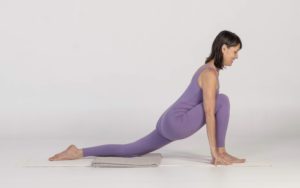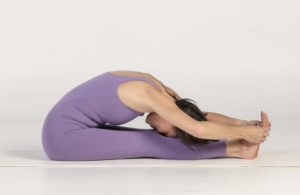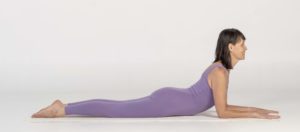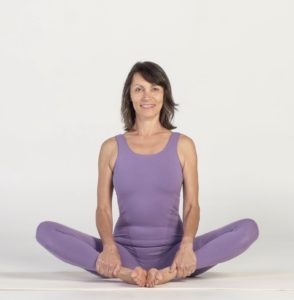
by Leza
Ancient yogis and Taoists believe there is energy running through the body. In Sanskrit, it is called prana, in Japanese ki, in Chinese qi and in Tibetan lung. This energy is connected by pathways, or meridians, (nadis in Sanskrit), which we can think of as “rivers of health.” Some researchers, including the founder of Yin yoga, Dr. Hiroshi Motoyama, believe that connective tissue is the pathway for energy flow, conducting the life force into every organ and area of the body.
In Taoist thought, every phenomenon in the world can be described in terms of yin and yang energy, and all are a mixture of both. Yin is the stable, unmoving, hidden, SHADOW aspect of things. Yang is changing, moving, REVEALED aspect. Cold is yin, hot is yang. Female is yin, male is yang. Dark is yin, light is yang.
Yin and yang are, of course, relative terms. We can’t look at the moon and say, “The moon is yin,“ but we can say, “Relative to the sun, the moon is yin.” We also have to consider the traits of the thing being compared. In a teacher training that I attended, Paul Grilley noted, “The heart is yin compared to the breastbone because the heart is hidden. But the heart is yang compared to the breastbone because the heart is softer, more mobile, more elastic.”
When we look at yoga poses from a Taoist perspective, the most important factor is elasticity of tissues. Yang tissues are more fluid-filled, soft, and elastic. Yin tissues, like connective tissues (ligaments, tendons and fascia) and bones are dryer, harder and stiffer.
Of course, in all yoga postures, both muscle and connective tissue are worked to some degree, but poses or movements that focus primarily on muscle are yang. Those that focus primarily on connective tissue are yin. Connective tissue is found in every bone, muscle, and organ, but it’s most concentrated in the joints. Over time, and with stress, aging, and lack of stretching, connective tissue gets stiff and “shrink-wrapped,” causing tightness, reducing mobility, and potentially impairing organ function. It’s important to keep these areas of the body fluid and supple, especially as we age and are more prone to injury.
From a Taoist perspective, much of Western yoga is yang because it focuses on movement and muscular contraction, such as in Sun Salutations, Vinyasa flow, or even active inversions like Handstand and Headstand, which fill muscles with blood. Yang yoga is beneficial because stretching is easier with muscles that are fluid. If you think of muscle as being like a sponge, it is easier to stretch it out when it is wet. Yang yoga removes energy stagnation.
But it might not be enough on its own. Seated meditation is a yin activity, but you can’t do it comfortably when your connective tissue is tight. It is good to move the body, get the blood flowing, and warm the muscles through yang yoga, then stretch the connective tissue through yin postures which are kept for longer holds. Active backbends, standing poses, arm balances, and active inversions are yang because they require muscular engagement to protect the structural integrity of the body.
The two main components of Yin yoga are:
- Poses are held for longer periods of time–generally, two minutes per pose.
- Poses stretch the connective tissue around the joints.
Yin postures, such as forward folds, stretch the ligaments along the back of the spine and help decompress the lower discs. Straight-legged forward folds also stretch the fascia and muscles in the back of the legs and neck/shoulder area.

Supported backbends increase flexibility in the spine and stretch the front of the torso and in some poses the fronts of the thighs.

Hip-opening postures stretch the connective tissue around the hip joints and pelvis.

Paul Grilley explains the optimal active-passive dynamic like this: “Traction is used with bone fractures to relieve the stress on fragile bones trying to knit back together. Once the bones are healed, the muscles are then strengthened to add support for the bone and joint. Same idea.”
Yin postures are beneficial in helping facilitate more comfortable, relaxed meditation postures. In meditation, the back should be kept as straight as possible while still remaining relaxed. A fundamental factor that affects the spine’s position is the tilt of the sacrum and the pelvis. When you sit up straight, you bring the pelvis into vertical alignment or with a slight forward tilt. Yin yoga works to promote flexibility in areas that are usually seen as non-malleable, like the hips, pelvis, and lower back.
Yin poses are also beneficial for maintaining flexibility, which is one of the four essential physical skills for healthy aging. See Maintaining Flexibility as You Age: Why and How for an overview of all the information we have on our blog about why and how to maintain flexibility as you age.
Finally, because the energy runs along the meridians in the connective tissue, each Yin yoga pose stimulates particular meridians or energy points in the body, stimulating organs such as the heart, lungs, bladder, kidneys, stomach, and liver.
Our yoga practice need not be binary. We can practice a mix of Yin and Yang yoga for healthy aging. Paul Grilley agrees: “Yin yoga by itself won’t develop the strength and stability a joint needs. Yang yoga by itself will not exercise the full range of motion. This is why different forms of yoga can and should be practiced as supplements to each other.”
For this reason, I integrate Yin yoga into my own practice and into my teaching. My go-to practice is a mix of yang poses for building strength and stamina coupled with yin poses for increasing flexibility, mobility and facilitating calm. For over two decades, I have found this middle way to be the best path to restoring physical, mental, and spiritual balance.
You can read more about Leza’s writing at www.lezalowitz.com and about her yoga studio and classes at www.sunandmoon.jp.
• Follow Yoga for Healthy Aging on Facebook and follow Nina on Instagram •Pre-order Yoga for Times of Change: Practices and Meditations for Moving Through Stress, Anxiety, Grief & Life’s Transitions here. • Order Yoga for Healthy Aging: A Guide to Lifelong Well-Being here.


I enjoyed the article and appreciate the information. I’ve read up on yin yoga a little, including one of Paul Grilley’s books. I was under the impression that yin was practiced with cold muscles and so Yang yoga (stuff like sun salutes) wasn’t done first. Unless the thinking has changed?
Hi Danette, thanks so much for your comment and thanks for reading the blog. When I was introduced to yin yoga over 30 years ago, it was typically done as a singular practice. Many people still only practice yin yoga on its own. Some teachers developed a yin-yang mix, and some practiced the yin style first, to get maximum stretch. For some students, this is too intense. Yoga is an individual practice, and for me, practicing a more yang style first, then practicing longer held yin poses works best with my body. I would be curious to hear about your practice, and also hear from others.